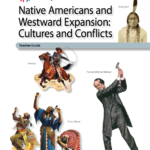Through photographs, letters, reports, interviews, and other primary documents, students explore the forced acculturation of American Indians through government-run boarding schools.
NHD Breaking Barriers: Americans and Native Americans
From the colonial era, relations between European settlers and Native American nations have been complicated. In 1803 Congress authorized and funded an expedition led by Meriwether Lewis and William Clark for exploration of the region and for better knowledge about American Indians of the Northwest in order to develop trade. About 30 years later, the United States forced the removal of Native Americans from their lands to make way for white American settlement. Congress and the president made treaties with Native American nations, but those treaties were not always respected as the United States continued to expand into the west. After Native Americans enlisted and served in both World War I and World War II, Congress passed legislation to begin to address longstanding Native Americans claims against the United States Government.
Anishnabe/Ojibwe/Chippewa: Culture of an Indian Nation
This lesson provides information and activities about one American Indian Nation, the Anishinabe, called Ojibwe in Canada and Chippewa in the U.S., and engages students in research on its history, location, and past and present culture.
Not “Indians,” Many Tribes: Native American Diversity
In this unit, students will heighten their awareness of Native American diversity as they learn about three vastly different Native groups.
Documents and Debates in American History and Government – Vol. 1, 1493-1865
The Core Documents Collection – Documents and Debates is structured around a series of topics, each based on a question for debate. For each topic, there is a collection of documents that, together, form the basis of argument over that topic – from those who debated it at a given point in American history. Volume One covers 1493-1865, and Volume Two covers 1865-2009.
The goal is to explore a series of critical moments in American history by asking questions for which there are not simple yes/no answers, but instead call for informed discussion and rational debate. The Documents and Debates readers also include appendices of additional documents, and together are a perfect fit for any American History survey course, including AP U.S. History.
Native American Cultures Across the U.S.
Teaching children about the First Americans in an accurate historical context while emphasizing their continuing presence and influence within the United States is important for developing a national and individual respect for the diverse American Indian peoples, and is necessary to understanding the history of this country.
American Indian Reservation Controversies
Reservation Controversies covers historic issues dealing with American Indian Reservations in the 1870s. This experience uses problem based learning (PBL), in which the student is confronted or faced with a real world problem which has no preconceived right or wrong answers. This scenario puts the student as prospective Indian Agent for the Comanche Indian reservation in 1873. Using various teaching/learning strategies, which include brainstorming, role playing, and oral presentations, the students access primary sources and other background sources to arrive at a recommendation, based on the information. The teacher, librarian, and other support staff act as guides or advisors through most of the process.
Native American Housing
Native American housing is frequently assumed to be represented by one or two well-known styles such as the teepee or pueblo. While these do reflect distinct tribal designs, they are not all inclusive and students should be exposed to a wider range of design. The lesson should also help students understand the relationship between environment and housing. Free registration for students and teachers required to access resource.
Native American-European Contact in Colonial Times
Drawing on the concept of worldview, students learn to think critically about the cultural differences between Europeans and Native Americans, and how those differences shaped interaction and potential misunderstandings between the groups as they negotiated trade and diplomatic relationships.
Native Americans: Cultures and Conflicts (CKHG Unit)

Across 7 lessons, this unit explores the ways of life of diverse Native American peoples and how their cultures were disrupted, displaced, and profoundly altered by westward expansion and American government policies and practices in the 1800s. Some of the content of this unit is tied to the “Pathway to Citizenship,” an array of civics-focused knowledge, questions, and activities.